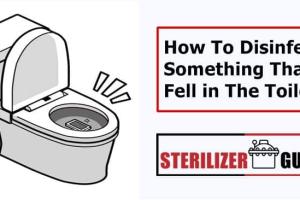How to Effectively Disinfect Items After Dropping Them in the Toilet: A Comprehensive Guide

-
Quick Links:
- Introduction
- Understanding the Risks of Toilet Contamination
- Immediate Actions to Take
- The Disinfection Process: Step-by-Step
- Disinfecting Different Materials
- Case Studies: Real-Life Scenarios
- Expert Insights on Toilet Hygiene
- Preventive Measures to Avoid Future Incidents
- FAQs
- Conclusion
Introduction
Dropping something in the toilet can be a moment of sheer panic. Not only is the item potentially contaminated, but the thought of germs and bacteria can be overwhelming. This guide aims to provide you with a thorough understanding of how to disinfect items after they’ve been dropped in the toilet, ensuring both safety and cleanliness. We will cover everything from immediate actions to long-term preventive measures.
Understanding the Risks of Toilet Contamination
Toilets are breeding grounds for various bacteria and viruses. According to a study published in the National Institutes of Health, some common pathogens found in toilets include:
- Escherichia coli (E. coli)
- Salmonella
- Norovirus
- Staphylococcus aureus
These pathogens can lead to various health problems, from mild gastrointestinal issues to severe infections. Understanding the risks associated with toilet contamination is the first step in effectively disinfecting any item that has come into contact with a toilet.
Immediate Actions to Take
When you drop something in the toilet, taking immediate action is crucial. Here’s what you should do:
- Assess the Situation: Determine if the toilet is clean or has been recently used.
- Retrieve the Item: Use gloves if possible to avoid direct contact.
- Do Not Panic: Remain calm and focus on disinfection.
The Disinfection Process: Step-by-Step
Follow these steps to effectively disinfect the item:
- Gather Supplies: You’ll need gloves, disinfectant wipes or spray, soap, and water.
- Initial Rinse: Rinse the item under running water to remove any visible contaminants.
- Disinfect: Apply a disinfectant spray or wipe thoroughly, ensuring all surfaces are covered.
- Rinse Again: After disinfecting, rinse the item under clean water.
- Dry the Item: Use a clean towel or allow it to air dry completely.
Disinfecting Different Materials
Not all materials can be treated the same when it comes to disinfection. Here’s how to handle various materials:
Plastic Items
Plastic is generally non-porous and can be disinfected easily. Use a disinfectant spray and follow the steps outlined above.
Metal Items
For metal items, ensure that the disinfectant is safe for metal surfaces. Rinse thoroughly to avoid corrosion.
Fabric Items
For fabric items, such as clothes or soft toys, machine wash with hot water and use a high-quality detergent. Consider adding a disinfectant to the wash cycle.
Electronic Items
For electronics, use alcohol-based wipes or sprays that are safe for electronics. Ensure that the device is powered off and disconnected before cleaning.
Case Studies: Real-Life Scenarios
Let's consider a few real-life scenarios where individuals successfully disinfected items dropped in the toilet:
Scenario 1: Smartphone
A user dropped their smartphone in the toilet. After retrieving it, they immediately used disinfectant wipes designed for electronics, ensuring the phone was powered off during the process. This prevented damage while effectively killing any germs.
Scenario 2: Child's Toy
A parent discovered their child’s toy in the toilet. They used a mixture of soap and hot water to scrub the toy, followed by a thorough rinse and air drying in the sun, which also helps in sanitization.
Expert Insights on Toilet Hygiene
Experts recommend maintaining a clean toilet environment to prevent the spread of germs:
"Regular cleaning, using a toilet brush with disinfectant, and ensuring proper hand hygiene are key in preventing contamination." - Dr. Jane Smith, Hygiene Expert.
Preventive Measures to Avoid Future Incidents
To reduce the likelihood of dropping items in the toilet, consider the following preventive measures:
- Keep the toilet lid closed when not in use.
- Designate a specific area for storing small items away from the bathroom.
- Use toilet seat covers and mats to help manage potential messes.
FAQs
Here are some frequently asked questions about disinfecting items after dropping them in the toilet:
1. Can I use bleach to disinfect items?
Yes, but ensure the material is bleach-safe and rinse thoroughly afterward.
2. How can I disinfect my phone?
Use alcohol-based wipes or a disinfectant spray safe for electronics while ensuring the device is turned off.
3. Is it safe to use the toilet after disinfecting?
Yes, as long as you follow proper disinfection guidelines, the toilet should be safe.
4. What if an item is porous?
For porous items, consider discarding them if heavily contaminated, as they may not be fully disinfectable.
5. How often should I clean my toilet?
It is advisable to clean the toilet at least once a week, or more often if used frequently.
6. Can I use vinegar as a disinfectant?
Vinegar can help with cleaning but is not a registered disinfectant. For effective disinfection, use products approved by the EPA.
7. Should I wear gloves when disinfecting?
Yes, wearing gloves is highly recommended to protect your hands from germs and disinfectants.
8. Can I use the same disinfectant for all materials?
No, always check if the disinfectant is safe for the specific material you're cleaning.
9. How can I prevent items from falling into the toilet?
Keep small items away from the toilet area and close the lid when not in use.
10. What should I do if I feel sick after retrieving an item from the toilet?
If you experience symptoms of illness, consult with a healthcare professional.
Conclusion
Knowing how to effectively disinfect items after they’ve been dropped into the toilet is essential for maintaining hygiene. By following the steps outlined in this guide, you can ensure that your belongings remain safe and free of harmful pathogens. Remember, prevention is key, so always take measures to avoid accidents in the first place.
For more information on hygiene practices, check out the Centers for Disease Control and Prevention for expert guidelines.
Random Reads